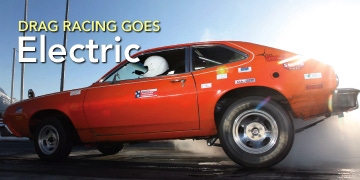September 2, 2011

When we first published our story on electric-vehicle drag racing in 2009, the excitement in that tight little world was growing. In the intervening two years, John "Plasma Boy" Wayland and his White Zombie Datsun have cracked the 11-second quarter-mile plateau, with a record time of 10.258 seconds and a speed of 123.79mph.
Wayland says his Zombie can go 100 miles on a charge. "We have the same range as a Nissan Leaf, but we have acceleration that's better than the Bugatti Veyron," he said, referring to the vehicle known as the fastest road-legal car in the world.
He attributes the faster times and longer range to a new lithium manganese cobalt polymer pouch battery from Dow Kokam. He also has boosted the size of the White Zombie's electric motors from 772lb-ft of torque in 2009 to 1,250 today.
"We are still the world's quickest-accelerating street-legal electric car," Wayland says. "And we plan to run a nine-second quarter-mile."

Here's the original article:
Roderick Wilde's cars are so powerful, they've done wheel stands. They've snapped axles. And, in drag races, they've "blown the doors off" 450-HP Dodge Vipers.
"If we went much faster, we would've made those Vipers look like they weren't moving," brags Wilde, a long-time racing enthusiast. "Those drivers might as well have thrown open their doors and walked."
If Wilde were just another speed-obsessed gear-head, his exploits might be little more than local legend. But Wilde isn't just another speed-obsessed racer. He's a speed-obsessed electric racer. And in the world of drag racing, as well as in the greater automotive universe, that makes his achievements special.
To be sure, Wilde's newsworthy exploits aren't unique. The National Electric Drag Racing Association (NEDRA) now counts about 100 members who've raced in Oregon, Michigan, Arizona, Florida, Washington D.C., and even England. Among them, there's much fashionably muscular talk of blowing doors off, putting hammers down, sucking amps, and slamming electrical current into motors. The racers' have cars with names like Maniac Mazda, Crazyhorse Pinto and White Zombie. But amidst all the loud, zealous banter, there's also speed. Lots of it.
"You get these guys who are driving their gasoline-powered Corvettes, Mustangs, and Audis, and they're losing on the drag strip to electric cars," says Mike Willmon, an engineer who also serves as the president of NEDRA. "It's opening up some eyes."
Indeed, heads are turning. A racer named John "Plasma Boy" Wayland, designer of the White Zombie, has pushed his street-legal electric Datsun to an extraordinary 11.4-second quarter-mile. Willmon, meanwhile, has covered a quarter-mile in 12.4 seconds in his electric 1978 "Crazyhorse" Pinto. And Bill Dube, founder of the so-called KillaCycle team, owns an electric motorcycle that covers a quarter-mile in a stunning 7.82 seconds, reaching speeds of 168 mph.
What's more, the engineering behind the vehicles is impressive, not only in terms of power development, but in the way the owners have created technologies on shoestring budgets. Thanks to the efforts of the electric racing community, there's now a motor controller capable of parsing out huge voltages and currents to the vehicles' drive motors. There's also a battery controller that enables them to charge their huge battery packs without damaging them.
Racers say that such new technologies are enabling them to do amazing things. "Rod raced against a GM EV1 awhile back and beat it with his backyard-built Mazda," says Wayland of his one-time competitor, RoderickWilde. "The guys from GM were shocked. Here they had a million-dollar prototype with AC drives, and along comes this long-haired guy from Washington who blows their doors off."
About the Author(s)
You May Also Like



